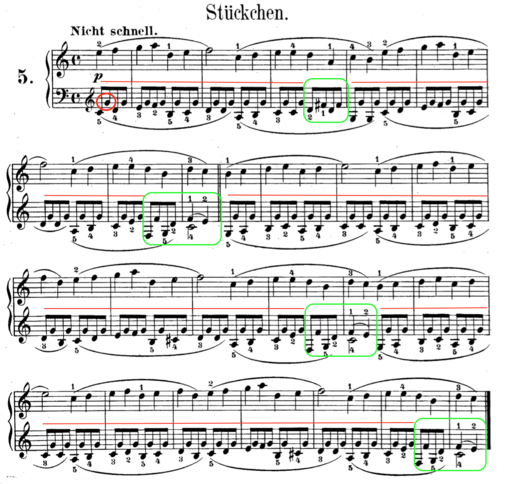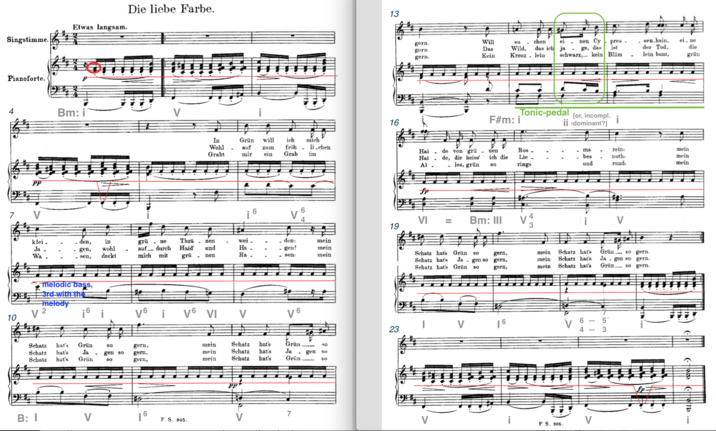Rhythmic Pedal In The Upper (Accompanying) Voices
The main feature of this model is the repeating tone that is present throughout the piece. Sustained tone (not rhythmical) in the middle voices tend to have different qualities, and is discussed in the section about textural pedal. The ‘upper voices’ in the title means simply that the pedal is not in the bass. Repetition in the accompanying voices is different than repetition in the thematic voice, that was discussed earlier.
Quite understandable, rhythmic pedal in the upper voices is typical for pianistic style: in an ensemble, one (melodic) instrument would have to be responsible for the steady pulse of one tone only, which could even be difficult to maintain throughout the composition. It is also characteristic of small forms. The ostinato is in most cases placed in the middle of the texture, sometimes on the top of it. From the beginning of the piece this tone establishes itself as a constant. It is usually consonant with the most harmonies, what is more, it often completes the chords. There is a cooperative interaction between the ostinato pitch and the other melodic events (notes), toward a harmonic goal.
The following example shows Schubert’s Die liebe Farben, from the cycle Die schöne Müllerin. The Lied is in B minor, the pedal tone is F#, the fifth of the key.
As it is obvious from the score, the simple harmonic progression is for the most part based on the tonic and the dominant chord (Bm, F#). Except from the beginning and the end where the bass is in low register and marks the foundation of the key (T and D), in many other bars it doubles the melody a sixth or a third below (mm.7-9, 16-18). Except from the introduction and the interlude/postlude, there are only three thin lines of texture: the melody (voice), the bass line, and the pedal tone. Pedal tone interacts with other pitches resulting in the harmonic progression. When the key shortly moves to F# minor (m.14), the pedal tone serves as a linking thread. There are only two (similar) moments when the pedal tone shortly moves up and back (m.4, m.25). Both times it is the final announcement of the melody; the embellishment of the pedal tone could be understood as intensification of the gesture (G becomes the 9th of the chord).
Through the interaction of the poem with the music, the omnipresent F# could become the musical symbol of the color green, that is obsessing the young miller.
In all but one single chord the pedal tone is a chord-tone. This one exception occurs in the short fragment in F# minor key (green selection in the figure). Interestingly, at this moment the pedal tone is supported by the harmonic pedal on the tonic, in the bass. In a way, this new pedal ‘justifies’ the persistence of the F# in the rhythmic-pedal layer, and makes it consonant - with itself, if not with the harmony.[1]
The pulsation of the pedal tone is established already in the opening of the piece. While the instrumental sections (intro/outro) feature sixteenth notes, the sung theme does not. The central part of the song unfolds in longer notes than the pulsation of the pedal. The pulsation of the melody is slower, in eighth-notes. If the accompaniment would follow this pace, the song would be more melancholic. As it is, the pulsation tempo of the pedal is in some sense conflicting with the pulsation tempo of the melody, and the result is certain restlessness that pervades the otherwise calm unfolding of the song. The effect of this rhythmic pedal is a feeling of distress, that permeates even the sections in major (B major, mm.10-11).
At last, one important thing should not be forgotten: although F# is present throughout the piece, it becomes pedal only at the moment it stands out as an independent part, a voice, in m.5. Only at the moment there is a conflicting interaction with any of the other musical processes, can a sustained pitch be felt as a pedal. In the opening bars, there is no such conflict. From m.5 on, the conflict is simple but effective: while all the voices move together, the pedal voice does not go along.
Such pedal-ostinato does not work as a sound-term (does not imply any consequent event), and thereby is stable. Once the listener recognizes (even if this later proves to be wrong) the pedal-ostinato in the accompanying voices model, she assumes that this ostinato layer is a constant, and does not expect any change related to it.
The presence of the pedal tone in virtually every bar is not a requirement for this model. There are many cases where it stops to make space for the cadence. The following image shows a short piece from Schumann’s Album für die Jugend. The pedal tone G (the fifth of the scale) is placed in the middle of the texture; the melody unfolds both above and under it (in parallel 10th). This is the organization of all the bars, except in the cadences. At the end of each phrase, only the upper voice retains its function: realizing the melody. Other two voices will realize the cadence: the lower voice turns into the real bass; the pedal voice completes the harmony. After the cadence, the voices will restore their original function.[2]
Black bird, by The Beatles, is using the tonic pedal point in a very much the same way as Schumann in Stückchen (listen to the guitar solo version):
In a guitar tutorial, ‘inverted pedal point’ (compared to the model being discussed) is listed as one of the improvisational techniques for rock and metal guitar. Guitar instructor Neal Walter (on www.guitarlicks.com) says: “pedal point thing, when they’re bouncing off that one note and landing on the tonic, that is a really good way to rethink how you construct your licks”
Rhythmic pedal in the accompanying voices has some characteristics of a textural layer: it occupies a particular place in the texture, and its persistent presence forms a constant textural line. Due to its low harmonic connotations (in the both examples above, the pedal is not the dominant, but the fifth of the key), its presence is felt as a repeated tone, mostly consonant. Even its exact pitch is less of importance.
The discussed type of pedal is itself not working as a sound term, but this pedal-model can work as an actor. It means that when the listener recognizes this model, this notion becomes important in the perception of other musical events.
Pedal Story ‘Movable pedal’ is related to this chapter. It reflects on Chopin’s Raindrop Prelude.


